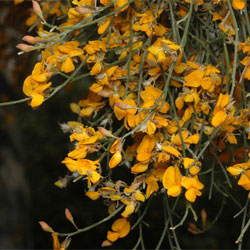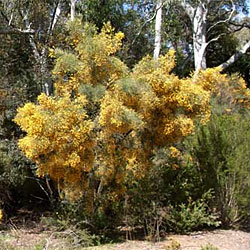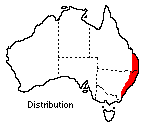Jacksonia scoparia
 |
 |
Dogwood
Jacksonia scoparia R.Br. ex Sm.
Jacksonia are pea-flowered shrubs or small trees found wild only in Australia, mainly in the west. Their distinctive feature is flat, angular or winged branchlets which are entirely leafless except in young growth. They are rarely grown in gardens, though they were sent by early discoverers for growing under glass in England from 1803.
 Jacksonia
scoparia (Dogwood), the species described here, is a beautiful small lightweight
tree of milder areas and mountains of New South Wales and Queensland. It has
been known to supply some drought fodder and also to have some minor value as
timber. The common name of dogwood is one given to various quite unconnected
plants and in this case is said to refer to the smell from the wood when burnt
- it is no indication of its ornamental value.
Jacksonia
scoparia (Dogwood), the species described here, is a beautiful small lightweight
tree of milder areas and mountains of New South Wales and Queensland. It has
been known to supply some drought fodder and also to have some minor value as
timber. The common name of dogwood is one given to various quite unconnected
plants and in this case is said to refer to the smell from the wood when burnt
- it is no indication of its ornamental value.
Jacksonia scoparia reaches about 4 m high - the height and size often needed in the garden - and is an interesting small shade tree, specimen or fence cover. Growth is helped by a twice-yearly dressing of blood and bone or a general fertiliser.
Most of the year the general effect is of a dense and softly drooping crown, with many thin branchlets somewhat tufted, and of a dull or greyish green. The slender trunk becomes dark and furrowed with age. This is a hardy and long-lived species in Canberra, and has survived severe droughts and storms. Adequate watering improves condition and flowering, as long as drainage is good. Flowers open about the third week of November and soon the branchlets are weighed down with masses of pea flowers 6 mm across. They are a soft light orange, and in some specimens there is a red blotch at the base of the standard petal. Each calyx is hairy, giving silvery tints. The delicate flowers fall quickly and continue for three weeks in moist, cool conditions or less in drought and heat.
Seeding is prolific, each pod holding one tiny seed. Like many other legumes the hard seeds require soaking in hot water before sowing, and each plant must be in a separate pot to facilitate transplanting without damage to the roots. An open, sunny position should be chosen and lighter soils appear to be preferred. The slender young plants may need protection from breakage by staking, while developing slowly.
Cut flowers do not last long in water but press well, the sprays retaining their bright orange when dry. No pests or diseases have been noticed apart from suspected rootrot which may have caused the loss of a mature tree growing in the path of water seepage at the Australian National Botanic Gardens.
Based on text by ANBG staff (1972)
Name meaning: Jacksonia scopariaJacksonia - after George Jackson, (?1780 - 1811), a botanical librarian; scoparia - brush- or broom-like, referring to the manner of growth |
![An Australian Government Initiative [logo]](/images/austgovt_brown_90px.gif)

